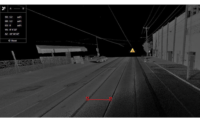The Connecticut Dept. of Transportation has a $5-billion plan to de-elevate a two-mile stretch of Interstate 84 that runs right through downtown Hartford. Naturally, residents are concerned.
As with every DOT, ConnDOT has been hosting public outreach meetings to explain design alternatives and potential impacts. One resident was particularly concerned about the visual impacts of removing a wall from a historic park, fearing it would expose parkgoers to the sight of the interstate highway, says Richard Armstrong, ConnDOT's transportation principal engineer.
So, an engineer "walked" her through a virtual image of the park with the wall removed, showing her that, "if you stand here, you will not see the highway ramps," says Armstrong. "We spent 45 minutes using the 3D model to show her what it would look like. There is no way we could have convinced her with a typical plan view or cross-section."
By clicking on various design alternatives, stakeholders can see what the visual impacts would be from, for example, a street corner or a building overlooking an altered street. They can "drive" along a reconstructed highway and interchange.
"One of the biggest problems in communicating with the community is helping them to understand it visually. They can get disoriented. It's hard to understand a bird's-eye plan view," says Armstrong. "With the 3D model, you can go to street level, bird's eye and everything in between. Navigating in the 3D realm, people can see what we're talking about."
The 3D modeling is provided by RDV Systems, which last fall released 123BIM Publisher to make the conversion of CAD platform data into 3D scenarios easier for engineering staff. Users of AutoCAD Civil 3D and Bentley MicroStation can import external data, such as aerial photographs, GIS data and SketchUp models, then publish their models in a browser-based environment, says Dolio Kafri, vice president of North America sales with RDV Systems. "This is not trivial, since the 3D digital documents created by the engineers are huge and require dedicated software to be viewed."
Once the 3D model is created using 123BIM Publisher, the costs of which start at $400 a month per seat, it is hosted on 123BIM. Hosting starts at $400 a month for three collaborators, says Kafri. Then, users can have a 360-degree view from any point on the 3D model using any web browser.
Lizette Martinez, a project engineer with Dewberry, says a 3D model of what will be Florida’s first-ever continuous-flow intersection helped Lee County residents to understand how it would work. "We wanted to teach the community how to drive through it." In two weeks, RDV provided the model. "We received great responses from the community," she says.
The 123BIM Publisher will be useful because designers still will have access to the data files in the cloud during construction, which will start this spring, Martinez adds.
The tool also has helped to inform the massive design efforts required on the I-84 project, says Armstrong. "The project will include reconstructing overpasses and lowering the Interstate. Local streets will pass over the freeway. We're using the tool to envision the bike and pedestrian experience on these overpasses—the width of sidewalks, visual screens, noise walls, landscaping."
ConnDOT has been using the RDV 3D modeling for about three years as a beta-tester, along with consultant TranSystems, and has posted many of the I-84 scenarios on its website.
"One feature we really like is that it's pretty easy on a mobile device. We haven't exploited this quite yet, but … if you have a tablet, you can go out to the project site and pull up the 3D model and literally turn [around]—and as you turn, the model will turn with you. We will exploit this ability for public [outreach]," says Armstrong.






Post a comment to this article
Report Abusive Comment